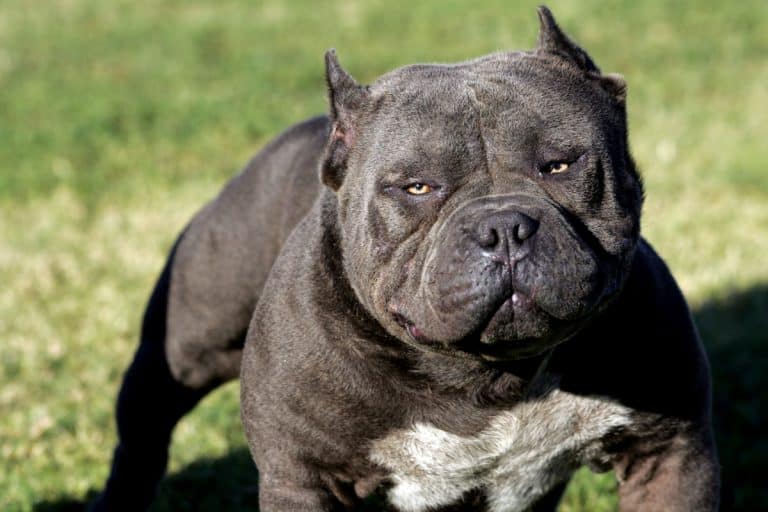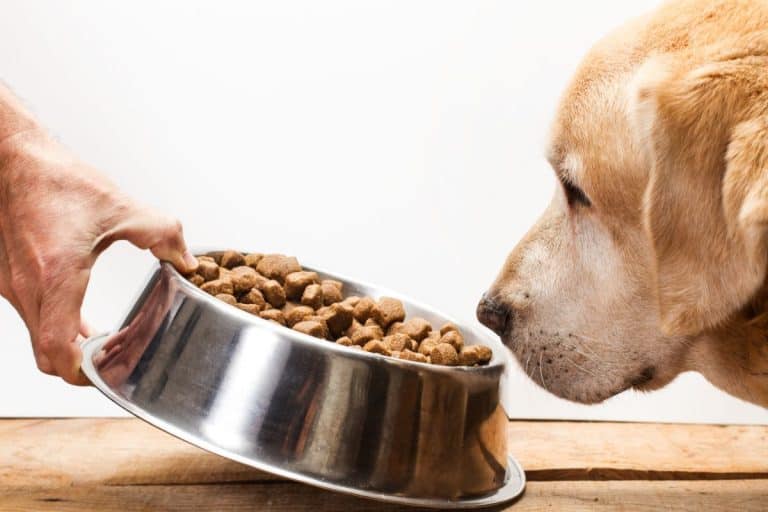How Much Chicken And Rice To Feed A Dog?
Chicken and rice are probably the most common food that is fed to dogs. Because of the low allergy rate and high protein content of this diet, many people are wondering how much chicken and rice to feed a dog.
The chicken and rice diet is known to have many health benefits for dogs, especially the ones that have stomach problems.
If you occasionally feed your dog the correct amounts of this diet, their overall digestive health will improve. Other benefits include helping in repairing muscles and stopping diarrhea.
It can be easy to prepare chicken and rice for dogs, but most dog owners get it wrong and end up hurting their pets than helping them.
To avoid making mistakes with this diet, this article will provide you with information on how you can feed your dog chicken and rice, and the correct amounts depending on their weight.
How Much Chicken And Rice To Feed Your Dog By Weight
| Dog's Weight (lb) | Dog's Weight (kg) | Chicken & Rice Per Day |
|---|---|---|
| 10 lbs | 4.5 kg | 0.75 cups |
| 20 lbs | 9 kg | 1.5 cups |
| 30 lbs | 13.6 kg | 2.25 cups |
| 40 lbs | 18 kg | 3 cups |
| 50 lbs | 22.6 kg | 3.75 cups |
| 60 lbs | 27 kg | 4.5 cups |
| 70 lbs | 31.7 kg | 5.25 cups |
| 80 lbs | 36 kg | 6 cups |
The ratio of feeding your dog chicken and rice is 2:1. This means that if you are giving your dog one cup of food, two-thirds should be rice and one-thirds should be chicken.
Ensure that the chicken is skinless and boneless. Continue giving your dog small amounts until their stool return to normal.
When your dog is recovering, keep them on the chicken and rice diet but slowly increase the time between meals until their stool is normal.
During the same time, begin switching your dog back to their normal food until they are fully recovered. You can do this by adding kibble into the rice and chicken and slowly increasing the amounts until the bland diet is completely removed.
A complete switch from the chicken and rice diet to their normal diet can upset their stomach, that is why a gradual change will give them time to ease into their normal diet.
If your dog does not show any improvement from the chicken and rice diet after a couple of days, take them to the vet as he/she can provide a better assessment and treatment.
When To Feed Your Dog Chicken And Rice?
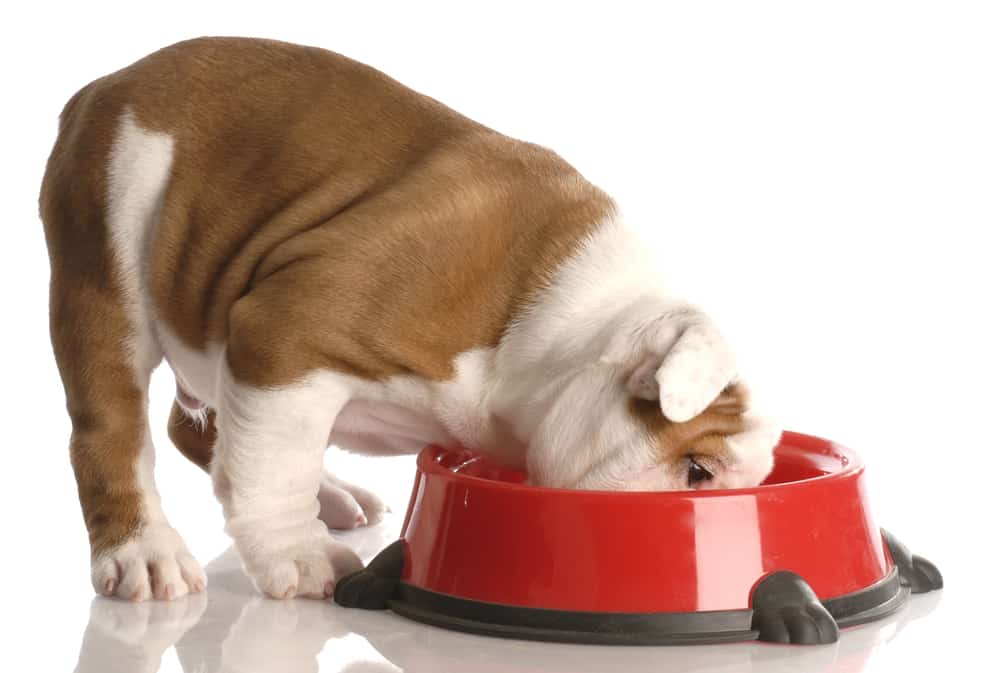
Also known as a bland diet, feeding your dog chicken and rice should be a recommendation of the vet when your dog is consistently suffering from diarrhea, has lost their appetite, has been vomiting for more than 6 hours, has serious constipation, or is recovering from a serious illness or surgery.
If you want to detect sensitivities or allergies that your dog might have, your vet will also suggest feeding them chicken and rice then slowly introduce the food items to determine their reaction.
Whichever the reason, your vet will inform you what to look out for so that you can transition your dog back to their normal diet.
They may also require you to take a fecal sample to them for testing to assess whether your dog is suffering from intestinal parasites which may need medication.
Your vet will never tell you to feed your dog chicken and rice for a long period because this diet does not have all the necessary nutrients that your dog needs to thrive.
While this diet is good for a few days, your dog can be deficient if they spend months eating chicken and rice.
Why Chicken And Rice?
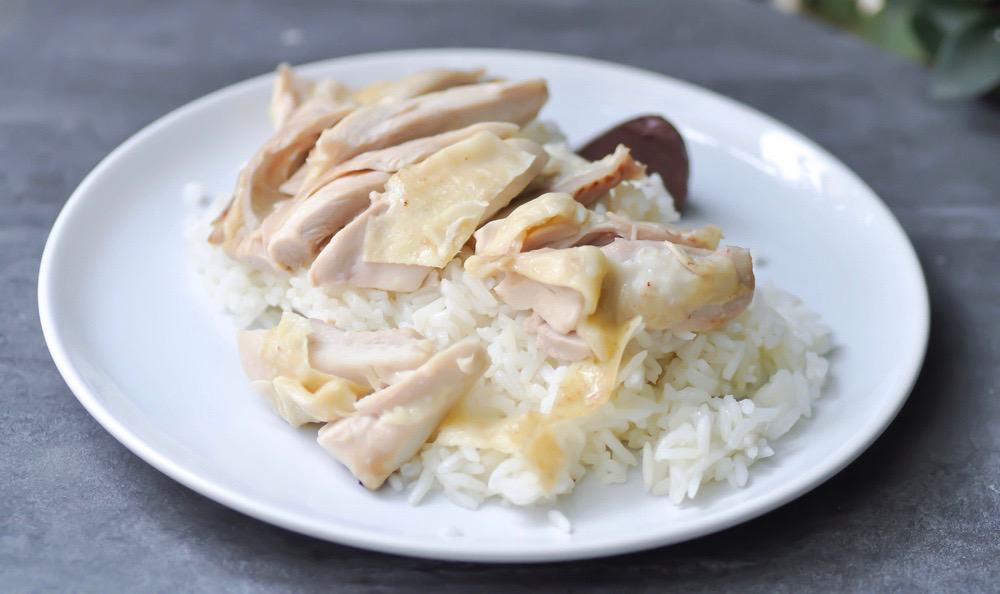
You may be aware of how much chicken and rice to feed a dog, but why chicken and rice? This section explains all.
Energy source
Chicken is a great source of energy that dogs need because it is high in protein.
It is also high in omega 6 fatty acids that help with nourishing your dog’s coat and skin. The glucosamine in the chicken is essential for healthy bones.
Good for sensitive stomachs
Chicken and rice are often suggested for dogs with stomach issues because it is easy to digest as it is simple and low fat and contain one carbohydrate and one protein source.
Dogs with food sensitivities, allergies, and intolerances are at risk of having diarrhea, unhealthy weight loss, and reduced energy which can lead to weakness, malnutrition, and other health issues.
Therefore, feeding your dog chicken will help with these issues as it is one of the least common causes of allergies in dogs.
Proteins, amino acids and fibers
Chicken has a complete profile of amino acids which are the building blocks of proteins.
Chicken in the stomach is broken down by enzymes and hydrochloric acid into smaller chains of amino acids which are then absorbed into the body to help with tissue repair. Chicken is not a caloric-dense food, so your dog can eat plenty of chicken but may not gain weight.
On the other hand, rice is rich in fiber, vitamin D, riboflavin, and iron that your dog needs. Vitamin D helps in regulating phosphorus and calcium levels.
Iron helps in the formation of hemoglobin in the red blood cells which aids in delivering nutrients throughout the body. Rice helps in regulating bowel movements by promoting the growth of good bacteria.
Gluten-free
Most dogs suffer from gluten intolerance or sensitivity like humans which often lead to rashes, stomach upset, and diarrhea. Since rice is gluten-free, it is a good alternative for carbohydrates gluten sources.
However, the rice should not be fed in high amounts and should not be the number one ingredient in your dog’s food.
Also, if your dog is diabetic and you feed them homemade food, you should avoid giving the rice as well as other simple carbohydrates.
It is recommended that you feed brown rice to your dog if rice is part of their regular diet because it has more nutrients than white rice.
Also, white rice has a high glycemic index meaning it has potential negative side effects on your dog such as diabetes.
But if your dog is sick, white rice is recommended because it is easy to digest and has the starch that is needed to stimulate your dog’s appetite.
How To Prepare Chicken And Rice For Your Dog
Feeding your dog rice and chicken begins with preparing the meal correctly. You should use white rice instead of brown rice and white chicken without fat and bones.
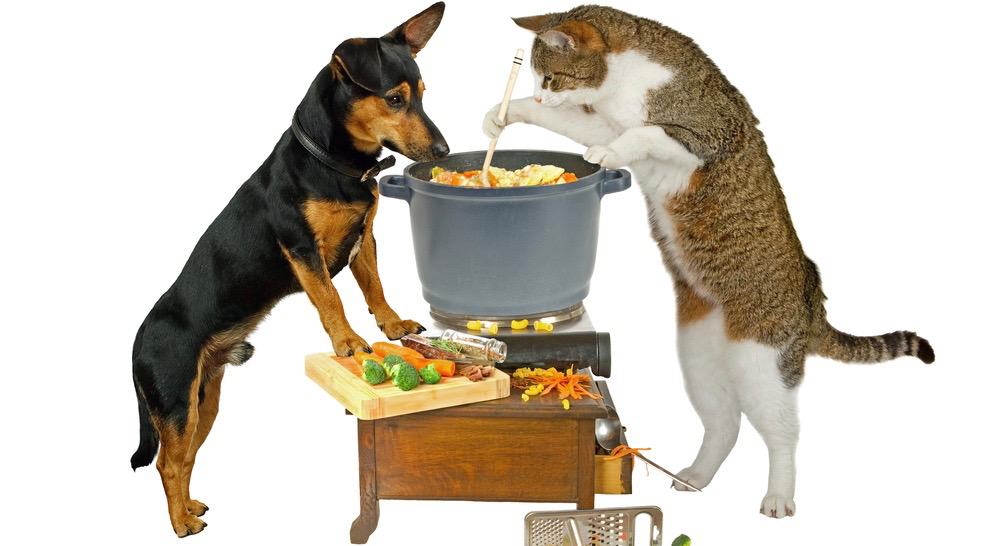
Chicken preparation
To prepare the meal, first cut the chicken into cubes. For large dogs, the chicken cubes should be an inch in size and for smaller dogs, they should be half an inch in size. The chicken cubes should be smaller if your dog has lost several teeth.
Then, put the chicken cubes into a sizable cooking pot and fill the pot with enough water to completely cover the chicken then bring it to boil.
Once the chicken is boiled, minimize the heat then leave it to simmer until it is completely white. The whole process should take around 10 to 30 minutes depending on the size of the cubes.
Next, remove the chicken from the water and spread it over a baking sheet or run cold water over the pieces to cool it.
Reserve the broth to use later. Remove any fat if any from the top of the broth and pour the liquid into a container.
Rice preparation
The next step is to cook rice in the chicken broth. If your dog is large, cook a cup of white rice but if your dog is smaller, reduce the amount of rice.
Start by washing the rice with lots of water. Stir it with your hands and rinse it multiple times until the water is clear afterward.
To give the rice added flavor, cook it in the chicken broth from earlier. Therefore, bring the chicken broth to boil then add the rice and let it boil as well. Cover the pot for 20 mins to let the rice cook. Once it is done, let the rice cool before serving it to your dog.
Mixing the Chicken and Rice
Once the rice and chicken are cool, mix them at a ratio of 1:2. This means 2/3 cup of rice and 1/3 cup of chicken if you are feeding your dog a cup of the meal.
If you have made a big batch, you can store the chicken in the freezer for up to two months and the fridge for three to four days.
Meal Tips
When preparing the rice and the chicken, do not use any seasonings as it can be dangerous for your dog. Also, do not use any butter or oils to cook them. You must avoid adding anything to this meal.
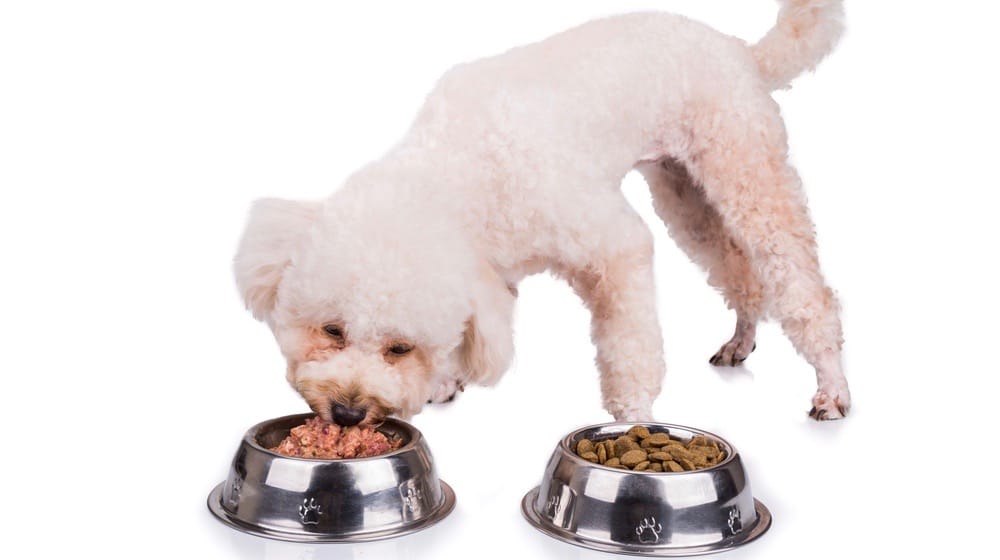
How Much Chicken And Rice For A Dog By Weight
You need to ensure that you are giving your dog the right amounts if you are feeding them chicken and rice. Since this meal is high in calories than the food you normally give your dog, you will need to feed them fewer amounts than you might expect.
The standard rice and chicken meal prepared as explained above has around 350 and 400 calories per cup.
The general rule of thumb is that dogs require about 25 to 30 calories per pound of their body weight per day.
For example, if your dog weighs 20 pounds they need 1½ cups of rice and chicken per day and if they weigh 40 pounds, they need 3 cups of rice and chicken per day. Since this value is an approximation, you need to confirm with your vet before feeding your dog a new diet.
How To Deliver Your Dog Their Chicken And Rice
Instead of splitting your dog’s food into two meals per day, you should give them smaller portions over four to six mealtimes.
This leads to less stimulation of the stomach which minimizes the muscular contractions helping ease diarrhea and vomiting.
Your vet will probably recommend that you feed your dog chicken and rice exclusively for two to three days or inform you what to look out for to know when your dog is feeling better.
They may also suggest that your dog fasts for a day before starting on the chicken and rice diet.
When your dog is well and ready to go back to their normal diet, start reducing their mealtimes and mixing their rice and chicken with their normal food. Start by making their meal 25% standard food and slowly increasing it up to 100% for about a week.
Since dogs have sensitive stomachs, quick changes in their diet can put them back to an upset stomach.
Alternatives To Chicken And Rice
There are reasons why you may consider feeding your dog an alternative to rice and chicken when they are under the weather.
One of the reasons could be they are constipated. The following are some of the alternatives to chicken and rice:
Pumpkin For Dogs
If your dog has an upset stomach, pumpkin is another great food for them especially if they are constipated.
Since it is high in fiber, it helps with regulating the digestive system. It is also high in essential minerals and vitamins such as Vitamin A, C, B6, and E, iron, niacin, phosphorus, magnesium, manganese, and potassium.
If your dog is constipated, add two tablespoons of pumpkin to their rice and chicken meal. Ensure that the pumpkin does not have any seasonings as they are toxic.
Bone Broth
If your dog is not doing well with solid food, feeding them bone broth will maintain their strength until they are ready to eat something solid.
It will also help in bringing back their appetite. You can use either chicken legs or beef bones to make the broth.
Baby Food
Since human baby food is designed for easy digestion, it is a good alternative.
If your dog is allergic to chicken, you can feed them the meat-based meals of the stage II variety. Check the ingredient list to ensure that there are no spices or seasonings added.
Commercial Dog Food Alternative
If you cannot prepare the chicken and rice at home, you can purchase a ‘bland diet’ that is already prepared for you.
Ensure that the brand you get this food from is reputable and high in quality. Speak to your vet for assistance.
Can You Feed Your Dog Chicken Organs, Feet, And Neck?
Chicken feet have glucosamine which is an essential nutrient required for maintaining joint health in dogs.
Also, chicken feet help in reducing the buildup of tartar in your dog’s teeth when they chew it. Chicken feet is suitable for older dogs as it helps them in fighting weakening joints and teeth.
Chicken heart, kidney, and liver have essential amino acids that are necessary for maintaining healthy skin and coat.
They also contain taurine, iron, zinc, biotin, and Vitamin A and B. Chicken neck contains calcium and helps in removing plaque from the teeth.
Can You Feed Your Dog Raw Chicken?
Yes, this is because raw chicken is safe for your dog and ideal for their health. Bones from raw chicken are safer than those from the cooked chicken because they are denser, elastic, and less likely to break and cause tears along the digestive tract.
Additionally, raw chicken is filled with essential nutrients that are needed to maintain your dog’s optimum health.
Also, raw chicken bone is a good teeth cleaner by removing the plaque and tartar from your dog’s teeth keeping your dog from having dental issues.
Precautions When Feeding Your Dog Raw Chicken Bone
Let your dog eat raw bone when you are available to monitor them.
Give your dog raw bones in moderation by limiting the bones intake to two a week and ensure the days for eating bones are well spaced.
Give your dog large bones so that they cannot swallow it whole and check on his size when feeding them with bones.
Keep kids and other pets away from your dog when he is munching on the bone.
When feeding geriatric dogs with raw bones, be careful because their teeth are not as they were, and bone might crack or damage their teeth.
Too many bones can cause constipation, therefore, try to avoid that.
Large marrow bones such as T-bones, knucklebones, and lamb cutlets are not the best to feed your dog because their outer rims are thick and can make your dog’s teeth crack.
Can Your Dog Get Sick From Eating Raw Chicken?
Your dog could get sick from eating raw chicken. This happens if the chicken has chemicals sprayed on it or is prepared in unsanitary ways.
However, if you observe the same care you use when preparing chicken for your family with your dog’s chicken, there should be no problem.
A common fear most dog parents have is salmonella which can be found in raw chicken. This is not limited to raw food only because even some kibbles have been recalled because of salmonella contamination.
Your dogs’ immune systems are built to take almost everything. They can fight off an invasion of bacteria from the raw chicken because sometimes you find them eating rotten rubbish and may not get sick at all.
However, this is not to say that dogs do not get sick from salmonella infection but just to say it is rare.
Arguments Against The Chicken And Rice Diet For Dogs
Although the chicken and rice diet is largely prescribed, some vets and dog owners disagree. Some, for example, don’t believe that rice and chicken are the best to feed your dog if they suffer from diarrhea.
There is also thinking that as rice is a grain it is inflammatory. This causes some dogs to not digest rice well because it takes too much work on the body to break down rice effectively.
They also believe that rice has no nutritional value other than carbohydrates, and the glycemic index of rice is high which can cause a spike in blood glucose once it hits the blood.
Also, it is believed that dogs have developed an increasing chicken intolerance rate because of the kind of chicken they are fed.
Most people feed their dogs with factory-farmed chicken instead of organic. These factory-farmed chickens are often pumped with antibiotics, fed with GMO grains, vaccinated about three times, and have a lifespan of one month.
FAQs
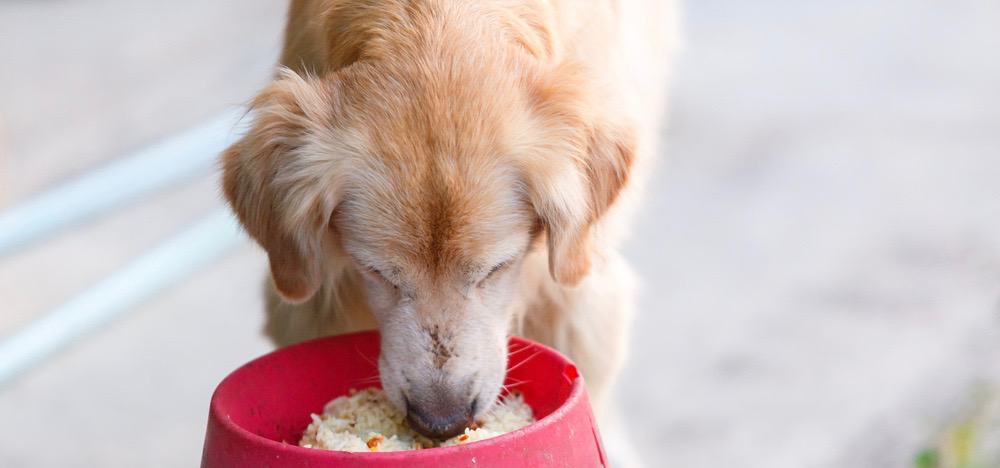
Can Dogs Eat Chicken And Rice Every Day?
Do not keep your dog on a rice and chicken diet for long. This dish is healthy, but it does not have all the nutrients needed in their bodies that they can also get from other sources such as vegetables and meat.
Your dog may develop allergies to the foods that they eat most and if they feed on rice and chicken for an extended period, they may develop an allergy to the chicken which can make you change your dog’s diet again.
Can Chicken And Rice Constipate A Dog?
Giving your dog rice and chicken should not make him constipate if you give him the right recipe, that is, chicken without bones and white rice. For brown rice, it is difficult to digest and can cause indigestion.
If you find that your dog is constipating because of this diet, feed your dog shredded chicken and drop the rice. A few tablespoons of cooked pumpkins will help fight constipation.
How Long Should I Feed My Dog Chicken And Rice?
The veterinarian will advise you on the signs to look out for to know when your dog is ready to transition to regular food from rice and chicken.
Normally, your dog should only be on a strict rice and chicken diet for up to three days. There are exceptions such as when your dog is recovering from surgery, or it is part of an elimination diet.
Final Words
If your dog is suffering from any digestive issues, a bland diet of rice and chicken is a great way of helping them.
This diet is also great for dogs who have lost their appetite and can be used as an elimination diet to detect any food sensitivities and allergies your dog might have.
Ensure that you do this diet the right way to avoid hurting your dog. Use white rice, avoid putting any seasonings on the food and feed them the right amounts according to their weight.
Keep your dog on this diet for two to three days before gradually transitioning back to his normal diet.
Always consult with your vet to help you with getting your dog back to his healthy and happy state.

